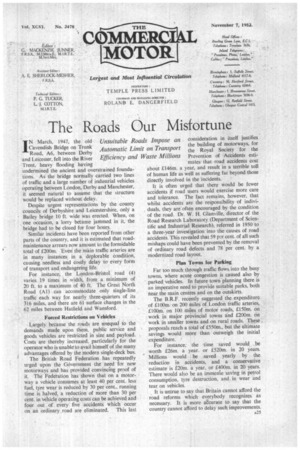The Roads Our Misfortune
Page 27

If you've noticed an error in this article please click here to report it so we can fix it.
IN March, 1947, the old Cavendish Bridge on Trunk Road, A6, between Derby and Leicester, fell into the River Trent, heavy flooding having undermined the ancient and overstrained foundations. As the bridge normally carried two lines of traffic and a large number of industrial vehicles operating between London. Derby and Manchester, it seemed natural to assume that the structure would be replaced without delay.
Despite urgent representations by the county councils of Derbyshire and Leicestershire, only a Bailey bridge 10 ft. wide was erected. When, on one occasion, a lorry betame jammed in it, the bridge had to be closed for four hours. Similar incidents have been reported' from other parts of the country, and it is estimated that roadmaintenance arrears now amount to the formidable total of £200m. Even the main traffic arteries are in many instances in a "deplorable condition, causing needless and costly delay "to every form of transport and endangering life.
For instance, the London-Bristol road (4) varies 19 times in width, from a minimum of 20 ft. to a maximum of 40 ft. The Great North Road (Al) can accommodate only single-line traffic each way for nearly three-quarters of its 316 miles, and there are 61 surface changes in the 62 miles between Hatfield and Wansford.
Forced Restrictions on Vehicles Largely because the roads are unequal to the demands made upon them, public service and goods vehicles are restricted in size and payload. Costs are thereby increased, particularly for the operator who is unable to avail himself of the many advantages offered by the modern single-deck bus.
The British Road Federation has repeatedly urged upon the Government the need for new motorways and has provided convincing proof of it. The Federation has shown that on a motorway a vehicle consumes at least 40 per cent. less fuel, tyre wear is reduced by 30 per cent., running time is halved, a reduction of more than 30 per cent. in vehicle operating costs can be achieved and four out of every five accidents which occur on an ordinary road are eliminated. This last consideration in itself justifies the building of motorways, for the Royal Society for the Prevention of Accidents estimates that road accidents cost about £146m. a year, and result in a terrible toll of human life as well as suffering far beyond those directly involved in the incidents.
It is often urged that there would be fewer accidents if road users would eXercise more care and tolerance. The fact remains, however, that whilst accidents are the responsibility of individuals, they are often encouraged by the condition of the road. Dr. W. H. Glanville, director of the Road Research Laboratory (Department of Scien_ tific and Industrial Research); referred in 1950 to a three-year investigation into the causes of road. accidents. This revealed that 59 rnr cent. of all such mishaps could have been prevented by the removal of ordinary road defects and 78 per cent. by a modernized road layout.
Plan Towns for Parking Far too much through traffic flows into the busy towns, where acute congestion is caused also by . parked vehicles. In future town planning there is an imperative need to provide suitable parks, both near the main centres and on the outskirts.
The B.R.F. recently suggested the expenditure of £100m. on 200 miles Of London traffic arteries, £100m. on 100 miles of motor roads, £150m. on work in major provincial towns and £200m. on work In smaller towns and on rural roads. These proposals reach a total of £550m., but the ultimate savings would more than outweigh the initial expenditure.
For instance, the time saved would be worth £26m. a year_ or £520m. in 20 years. Millions would be saved yearly by the reduction in accidents, and a conservative estimate is £20m. a year. or £400m. in 20 years. There would also be an immerAe saving in petrol consumption, tyre destruction, and, in wear and tear on vehicles.
It is untrue to say that Britain cannot afford the road reforms which everybody recognizes as necessary. It is more aecurate to say that the country cannot afford to delay such improvements.




























































































